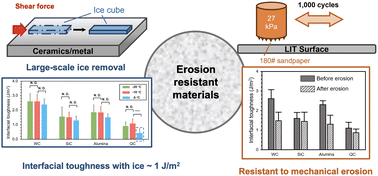Erosion-resistant materials demonstrate low interfacial toughness with ice and superior durability†
Abstract
The strong adhesion of ice to surfaces results in unwanted effects in various industrial activities. However, current strategies for passive ice-phobic purposes lack either scalability or durability, or both, in industrial applications. In this study, erosion-resistant materials, including ceramic-based (WC, SiC, and alumina) and metal-based (a quasicrystalline coating, QC), were studied for their ice-phobic properties via push-off tests with bulk-water ice from −5 to −20 °C. Although their ice adhesion strengths were high (>400 kPa), their interfacial toughness with ice was quite low (1.1 to 2.6 J m−2) and comparable to polymeric surfaces. The force per width required to remove ice on the QC surface was even lower than that of a silicone (Sylgard 184) surface for an ice length of 7.0 cm. The low interfacial toughness of the erosion-resistant materials with ice was also retained after 1000 cycles of linear abrasion under a pressure of 27.0 kPa. The findings of this work expand the material selection options for durable large-scale ice-phobic applications and could enlighten the use of erosion-resistant materials in harsh industrial environments requiring effective de-icing.

- This article is part of the themed collection: Materials Horizons 10th anniversary regional spotlight collection: The Americas


 Please wait while we load your content...
Please wait while we load your content...